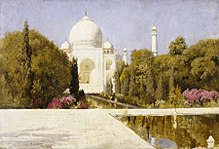This is an old revision of this page, as edited by 59.184.34.185 (talk) at 09:45, 2 April 2016. The present address (URL) is a permanent link to this revision, which may differ significantly from the current revision.
Revision as of 09:45, 2 April 2016 by 59.184.34.185 (talk)(diff) ← Previous revision | Latest revision (diff) | Newer revision → (diff)| Ustad Ahmad Lahauri | |
|---|---|
| Born | Badakshan |
| Died | India |
| Occupation | Architect |
| Buildings | Taj Mahal |
Ustad Ahmad Lahauri (Template:Lang-fa) was an architect. He was chief architect of the Taj Mahal in Agra , India. built between 1632 and 1648. He has been described as an architect in the court of Shah Jahan.
Life

Shah Jahan's court histories emphasise his personal involvement in the construction and it is true that, more than any other Mughal emperor, he showed the greatest interest in building, holding daily meetings with his architects and supervisors. The court chronicler Lahouri, writes that Shah Jahan would make "appropriate alterations to whatever the skilful architects designed after many thoughts, and asked competent questions."
In writings by Lahauri's son Lutfullah Muhandis, two architects are mentioned by name; Ustad Ahmad Lahauri and Mir Abd-ul Karim. Ustad Ahmad Lahauri had laid the foundations of the Red Fort at Delhi (built between 1638 and 1648). Mir Abd-ul Karim had been the favourite architect of the previous emperor Jahangir and is mentioned as a supervisor, together with Makramat Khan, for the construction of the Taj Mahal.
See also
Notes
- Koch, p.89
- UNESCO advisory body evaluation
- Begley and Desai (1989), p.65
- ^ Asher, p.212
- Dunkeld, Malcolm (Ed) (June 2007). "Construction history society newsletter" (PDF). Chartered Institute of Building. Retrieved 2007-07-23.
References
|